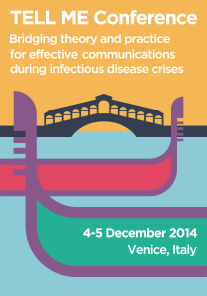Risk communication and social media: two sides of the same coin
Everything started at the beginning of September in San Francisco, at the Interscience Conference on Antimicrobial Agents and Chemotherapy, when Dr. Danuta Skowronski, an influenza expert at the B.C. Centre for Disease Control, took the floor to speak about her work. A work that ground its roots during the 2009 flu pandemic, when people who got a flu shot for the 2008-09 winter seemed to be more likely to get infected with the pandemic virus than people who hadn't received a flu shot. Dr. Skowronski and her collaborators recreated the event in ferrets and found that the animals in the vaccine group became significantly sicker than the control animals, though all recovered.
These results, together with some previous observations, seem to suggest that getting infected with a natural virus gives you not only protection against that virus but also against similar viruses, whilst getting immunised with the seasonal vaccine could lead to a less broad protection. A paradoxical and not-so-simple story, whose dynamics are still unclear and under debate amongst researchers. However, Dr. Skowronski insisted that her findings should not deter people from getting seasonal flu shots because “our findings are unique to the pandemic” and “pandemics are infrequent occurrences, but seasonal influenza recurs on an annual basis. It’s a substantial cause of morbidity and mortality and the seasonal vaccine substantially protects against that severe outcome due to seasonal influenza.” Also, the phenomenon revealed by Dr. Skowronski has been already observed in previous studies whose authors, however, always warned against jumping quickly to the conclusion that vaccines are bad. Oversimplify is not the best way to roam, in science. Halting annual vaccination of children, especially those at high risk for complications, could lead to dramatic consequences. Also, more studies are necessary to unravel the dynamics underlying the development of immune response to virus and to develop broadly protective vaccines, and progress has been made.
This is how science works: with prudence, without drawing hasty conclusion and avoiding potentially dangerous oversimplification. Unfortunately, this is not always how communication works in the Web 2.0 era. Rapidity and shortness are basic requisites for a news, but these two features also have their drawbacks: how easy to misinterpret – or intentionally manipulate – a complex story, especially a scientific one, when it has to be condensed in few, quick lines, or words. That is exactly what happened with Dr. Skowronski announcement: easy to guess, it has been spreading quickly on Twitter – as you can see from the TellMe Twitter spot – with a dramatic heading: “Confirmed! Flu Vaccine INCREASES Risk of Serious Pandemic Flu Illness”. Such an alarmist title may easily divert public attention from that grey-shaded zone where key details dwell, leading to an incorrect information. Not surprisingly, the sounding board of this big wave of tweets was a post wrote by Dr. Joseph Mercola on his website, where he used Dr. Skowronski’s study to criticize vaccination campaign and vaccine industry. It is important to note that Mercola has been often the subject of criticism due to his unsubstantiated claims against several standard medical procedures, including vaccination, and the use of prescription drugs and surgery to treat diseases.
However, cases like this of misinterpretation of scientific results should not lead to the conclusion that social media are “evil” for science. On the contrary, they can be an invaluable resource both for researchers and science communicators. An outstanding example come from the work of Dr. Patty Kostkova, Senior Research Fellow and Head of City e-health Research Centre (CeRC) at City University in London. In 2011, her team analysed three million tweets during the 2009 swine flu outbreak, looking for the word “flu”. They then compared them with the number of actual cases reported by the Royal College of General Practitioners (RCGP) – the professional membership body for family doctors in the UK – finding that the Twitter discussion, once cleaned of the noise which is part of it, could actually predict the pandemic up to a week before the official surveillance.
Dr. Kostkova’s work represent an efficient and innovative way to take advantage of the quickness of social media and should be taken as an example of the best way for researchers, medics and scientific journalists to deal with the new advances in technology and communication: without prejudices and with the awareness that they are tools that can become incredibly efficient when handled with wisdom, creativity and a solid scientific approach.


